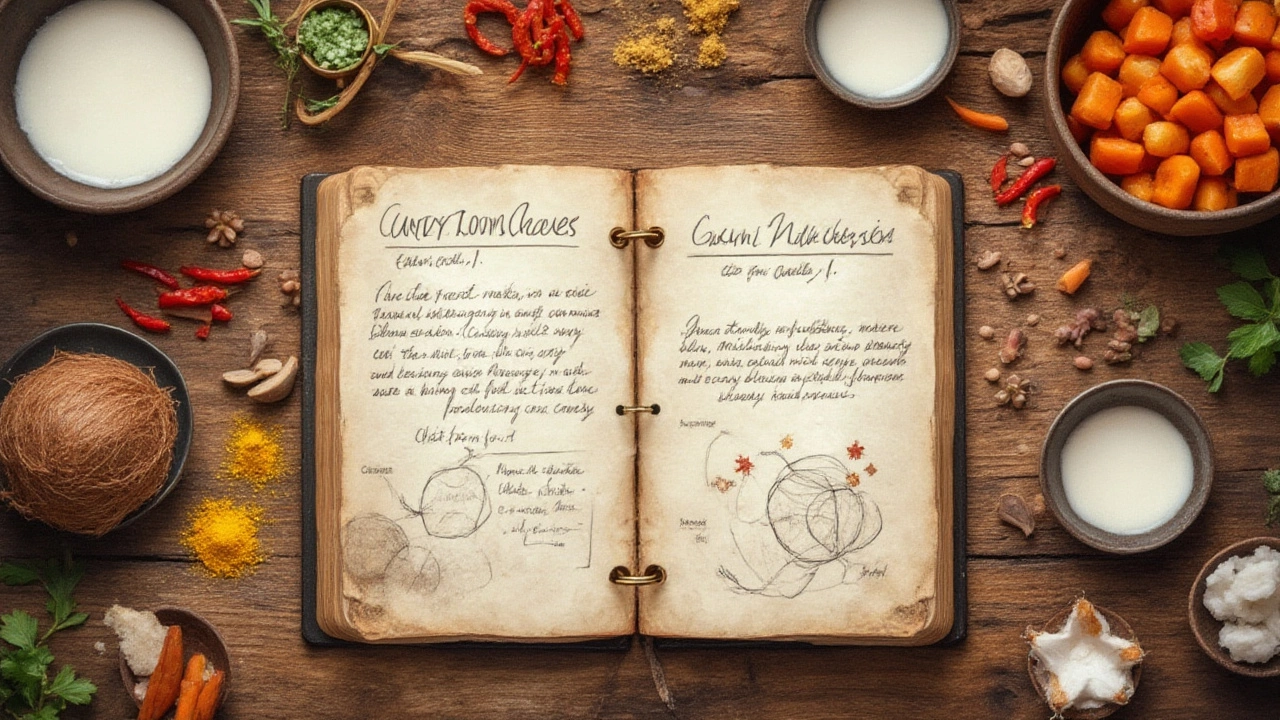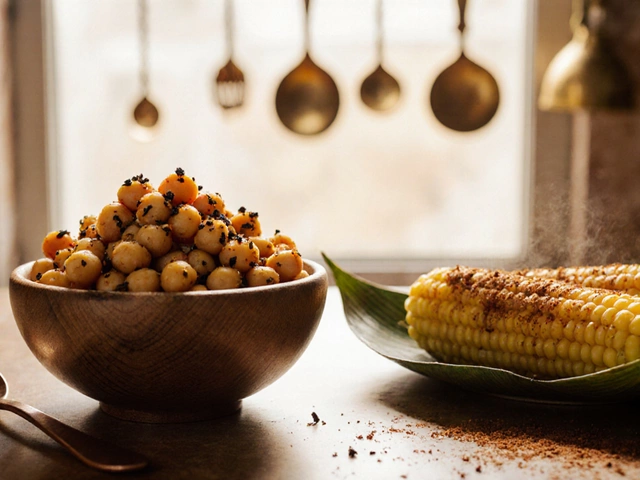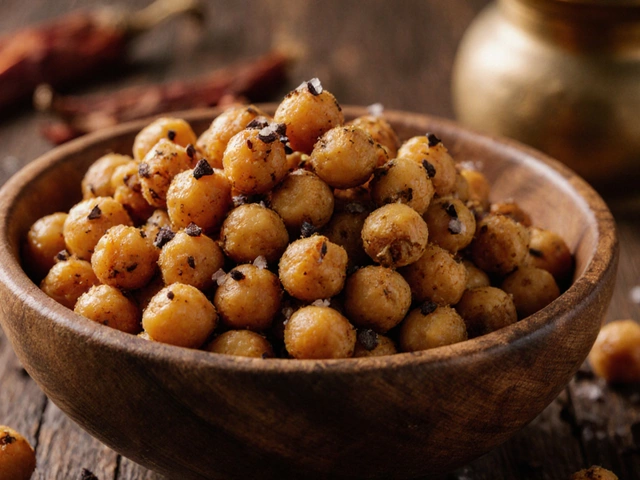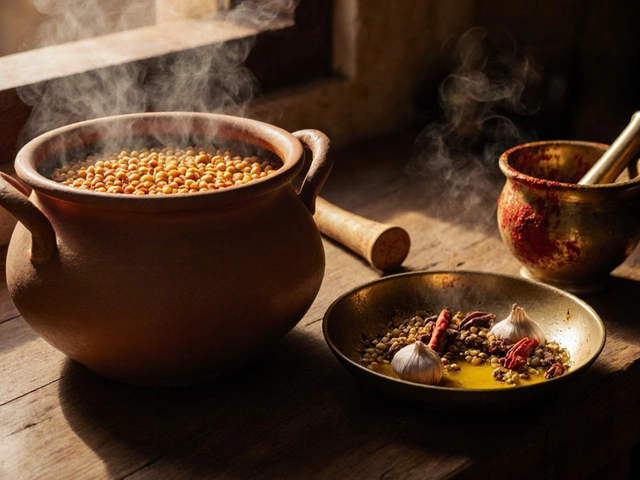Ever added a can of coconut milk to your curry and stood there, squinting at the simmering pot, wondering if it’ll ever get as thick and luscious as the restaurant stuff? The answer isn’t as simple as “yes” or “no.” What happens to your curry after that swirl of creamy coconut milk actually depends on a bunch of things—how long you simmer, what else you toss in, and even the brand or style of coconut milk you grab from the shelf. Curious? Get ready to crack open all the details, kitchen mishaps, surprising facts about coconut milk, and why sometimes your curry comes out silky smooth... and other nights, it pours like soup.
How Coconut Milk Works in Curry
Coconut milk isn’t some magical thickener that’ll transform your curry the moment you tip the can in. It’s mostly water—sometimes as much as 60%—mixed with coconut cream and a small blend of natural emulsifiers. The key thickening players are fat and a tiny amount of proteins. Full-fat coconut milk clocks in around 17-24% fat, while “lite” versions drop closer to 7-9%. The higher the fat, the creamier and richer your curry gets. But here’s the thing: coconut milk by itself only thickens a sauce if you simmer off enough water for the fat and solids to work their magic. If you add coconut milk and then barely heat it, or pour in too much, your curry can end up loose and runny.
Coconut milk is common in South and Southeast Asian dishes for its creamy mouthfeel, not so much as a direct thickener. Thai green curry, Malaysian laksa, South Indian seafood curries—these rely on coconut milk for softness and to mellow out spice. In traditional recipes, other thickeners like ground nuts or a paste of blended onions, ginger, and tomatoes often start the thickening process. Only afterward is coconut milk added for that signature silky finish. Without these extra ingredients, coconut milk alone needs a long simmer to reduce and thicken. But if you simmer too hard or too long, especially with low-fat coconut milk, you risk splitting the milk—turning your curry into a grainy mess. Keep it at a gentle bubble!
Types of Coconut Milk and Their Thickening Power
Walk down the aisle and you’ll see all sorts of coconut milk options—canned, boxed, full-fat, lite, coconut cream, even coconut beverage (which won’t do your curry any favors). Canned full-fat coconut milk is the thickest and richest, with plenty of fat to coax out that velvety sauce. Coconut cream is even thicker, almost pudding-like, and just a spoon or two can turn even the thinnest curry luxurious. Lite coconut milk is watered down and won’t thicken as much without extra time on the stove. That’s why it’s a favorite if you’re *avoiding* creaminess, not aiming for it.
Check your labels for stabilizers or gums—many store brands add guar gum or xanthan gum to help prevent splitting, but they also slightly thicken the milk. If you’re after traditional flavor and texture, look for brands with just coconut and water. But, honestly, for weeknight dinners where you need a little insurance against a separated curry, the added gums are pretty harmless (and might even save your sauce from disaster).
Classic Methods to Get Thick, Creamy Curry
Let’s say you’ve poured in your coconut milk and things still look watery. What do old-school cooks do? Many Indian and Southeast Asian cooks start with a fried spice and onion base—called a masala. These onions, when cooked down, release natural sugars and break apart, helping absorb liquids and thicken the sauce. Tomatoes, ground nuts like cashews or almonds, or even a scoop of chickpea flour all add body without muting flavor. You can blend some of your cooked onions back into the sauce, or mash in a little cooked potato. Each technique bumps up thickness without needing to rely on coconut milk alone.
Some cooks like to stir in coconut cream at the end, off the heat, for bonus richness. Others let the curry cool with the lid off, which helps excess water evaporate and leaves behind a thicker, more concentrated sauce. Keep a close eye if you simmer—the fat floats to the surface when coconut milk is heated, so stir gently to keep everything cohesive. And don’t be tempted to blast your curry over high heat! Rapid bubbling can break the emulsion and leave your curry grainy.

Surprising Facts and Tips for Perfect Coconut Curry
Did you know coconut milk separates into two layers in the can? The thick cream rises to the top, while coconut water settles below. In Southeast Asia, recipes often call for "cooking the cream" first—this means scooping out the top layer and gently frying it until the oils separate. This step creates a richer, almost caramel flavor base for your curry, locking in extra thickness from the start. If you want a thicker sauce, use only the creamy layer, reserving the watery part for soups.
Here’s a wild fact: a 2020 food lab test found that reducing 400ml of full-fat coconut milk by simmering for 30 minutes can cut water by nearly half, increasing thickness by over 60%! That kind of patience pays off, especially if you love your curry to cling to every grain of rice. Another hack? Add a tablespoon of cornstarch dissolved in cold water towards the end—not traditional, but it works in a pinch if your curry’s just not thickening.
On the flip side, some people use desiccated coconut, coconut flour, or even shredded coconut to thicken curry. These absorb liquid, bulk up the sauce, and give a sweet, nutty finish. Don’t add too much or you’ll end up with a paste instead of a pourable curry.
| Type of Coconut Milk | Fat Content | Thickening Power | Best For |
|---|---|---|---|
| Full-fat coconut milk | 17-24% | High | Rich, creamy curries |
| Lite coconut milk | 7-9% | Low | Light, thin sauces |
| Coconut cream | 20-25% | Very high | Ultra-thick, luscious finishes |
| Boxed/canned beverage | 2-4% | Minimal | Not meant for curry |
Common Mistakes and How to Fix Watery Curry
Ever served dinner, looked in the pot, and realized your curry’s a puddle? Don’t panic. The number one mistake is not simmering long enough after adding coconut milk. Set your stove to medium-low, cover just part of the pot so steam can escape, and give it 15-30 minutes to gently reduce. If your dinner deadline’s looming, use a thickener: mix a tablespoon of rice flour, chickpea flour, or arrowroot with some cold water, then whisk that slurry into your sauce. Let it simmer a few minutes to work.
Avoid boiling aggressively. High heat splits the coconut milk and makes the fat rise, leaving behind thin, watery liquid and grainy bits that won’t ever come back together. Instead, cook low and slow. Skim off extra coconut oil if you like, or stir it back in for richness.
Season carefully after you’ve thickened the sauce. Sometimes reducing concentrates salt and spice, so taste near the end. Add fresh herbs (like cilantro or curry leaves) at the last minute, since simmering can dull their flavor.
Remember, different curries need different textures. Thai curries are usually a touch looser than Indian-style ones—the rice soaks up the extra sauce, and the flavors shine through lighter. If you’re following a recipe, check for regional style clues before thickening too much or too little.
Putting It All Together: The Secret to Creamy, Thick Curry
So, will coconut milk thicken your curry? Yes—if you use full-fat, simmer gently, and give it time. But a truly unforgettable curry gets its texture from teamwork: a strong base of sautéed onions or paste, plenty of fat from coconut milk or cream, and a little help from natural thickeners when needed. Lean into your senses as you cook—if the curry coats the spoon and clings, it’s thick enough. If it slides off or pools like broth, it needs more patience or a helping hand.
Next time you reach for coconut milk, check the label, start with the thick cream if you want extra body, and let your curry bubble gently instead of boiling. Play with add-ins like ground nuts or a spoonful of flour if you want to push the thickness further. The real secret? Taste as you go, adjust on the fly, and enjoy the subtle dance between creamy and spicy that only coconut milk can bring. Happy cooking!





